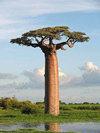Stem and caudex anatomy of succulent plant species
IF 0.6
4区 生物学
Q4 PLANT SCIENCES
引用次数: 1
Abstract
ABSTRACT Succulent angiosperm plants are characterized by the presence of large amounts of water storage tissue as an adaptation to habitats where water is unavailable seasonally or in microhabitats where water is of limited access. In this study, I describe the anatomy of stem and caudex of ten species of succulent plants from eight plant families in the Rosids clade. There are two characteristics of wood among all species with single continuous cambium or successive cambium: 1) extensive parenchyma tissue in ray system and/or axial system; and 2) extensive thin-walled fiber tissue in the axial system. Out of ten species, five present proliferation of the parenchyma tissue in their radial system: Ceropegia africana R. Br., Momordica rostrata Zimm., Oxalis megalorrhiza Jacq., Adenia glauca Schinz and Cyphostemma juttae (Dinter & Gilg) Desc. Five species were fibrous-wood succulents: Jatropha curcas L., J. macrantha Müll. Arg., Adenium obesum (Forssk.) Roem. & Schult., Pelargonium carnosum (L.) L'Hér. and Moringa drouhardii Jum. Out of ten, one presents an axial system without visible fibers: Cyphostemma juttae (Dinter & Gilg) Desc. Despite to belong to seven different orders, the studied species show structural similarity: extensive parenchyma in the ray system and thin-walled fibers in the axial system. These results suggest multiple independent origins for the anatomical structure of succulence.多肉植物的茎和根解剖
多肉被子植物的特点是存在大量的储水组织,以适应季节性水不可用的栖息地或水获取有限的微栖息地。本文描述了蔷花科8科10种多肉植物的茎和根的解剖结构。在所有具有单一连续形成层或连续形成层的树种中,木材有两个特点:1)射线系统和(或)轴向系统中有广泛的薄壁组织;2)轴系有广泛的薄壁纤维组织。在10个种中,有5种在它们的放射状系统中存在薄壁组织的增殖:Ceropegia africana R. Br。,苦瓜。大黄草;麻疯树(Jatropha curcas L.)、macrantha m (J. macrantha m ll.)为纤维多肉植物。参数。(福斯克)Roem。& Schult。,龙葵(L.)我是什么。辣木和辣木。在10种植物中,有一种呈现出没有可见纤维的轴向系统:Cyphostemma juttae (Dinter & Gilg) Desc。尽管属于7个不同的目,但所研究的物种显示出结构上的相似性:射线系统中有广泛的薄壁组织,轴向系统中有薄壁纤维。这些结果表明多肉的解剖结构有多个独立的起源。
本文章由计算机程序翻译,如有差异,请以英文原文为准。
求助全文
约1分钟内获得全文
求助全文
来源期刊

Adansonia
生物-植物科学
CiteScore
1.30
自引率
12.50%
发文量
24
审稿时长
>12 weeks
期刊介绍:
Adansonia is a fast-track and peer-reviewed journal of plant biology, devoted to the inventory, analysis and interpretation of vascular plants biodiversity. It publishes original results, in French or English, of botanical research, particularly in systematics and related fields: morphology, anatomy, biology, ecology, phylogeny, biogeography, etc. All articles published in Adansonia are compliant with the different nomenclatural codes. A copyright assignment will be signed by the authors before publication.
 求助内容:
求助内容: 应助结果提醒方式:
应助结果提醒方式:


